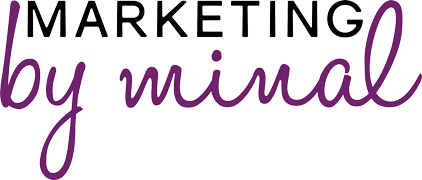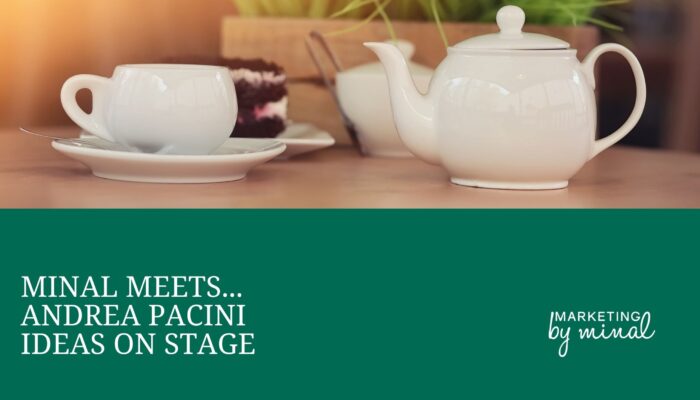Minal meets… Andrea Pacini, Ideas on Stage

Does the idea of presenting make you run for the hills? For every small business owner, being able to present their ideas, products or services and their business is a must. That’s why I decided to interview Andrea Pacini of Ideas on Stage and get his top presentation tips.
I attended one of his presentations and came away armed with presentation tips to make my own presentations better. So, I thought you should benefit from his experience too. Grab a cuppa and settle in to read how you can become a presentation maestro.
Minal: Tell me a bit about your business and when you started.
Andrea: At Ideas on Stage we are a team of public speaking and presentation coaches. We started in 2009 and in the last ten years we have worked with clients such as Microsoft, Lacoste, The World Bank and over 300 TEDx speakers. We specialise in helping CEOs and entrepreneurs unlock more sales and business success through great presenting. Our vision for the next ten years is to help as many impact-driven entrepreneurs as possible share their message, make an impact and be memorable.

Minal: Tell us why we should think about the way we present.
Andrea: Effective presenting is the single greatest skill to boost your business or career. If you want to land your dream job, sell products, lead teams, build brands or trigger movements, you have to be able to persuade and inspire people. The best way to do this is by communicating and presenting effectively. If you want to survive and thrive in the current business climate, you have to take your presentation skills to a higher level.
Minal: When planning a presentation, where do you recommend people start?
Andrea: Start analogue: pen and paper, flip-charts, whiteboards. In the planning phase, forget the technology. It’s hard to be creative and to develop a compelling message if all you do is open PowerPoint and create some slides. As John Cleese said, “We don’t know where we get our ideas from. What we do know is that we do not get them from our laptops.”
Minal: How do you recommend presenters keep their audience engaged?
First and foremost, you need to know your audience. Who are they? What do they need? What do they expect from your presentation?
Then, you need to identify your key messages focusing not only on what your audience needs to know but also on what they need to believe, feel or do after your presentation. It’s hard to keep them engaged if you just share some information.
You also need to develop a clear storyline that helps them follow you and remember what you say. The simplest presentation structure is a basic 3-act play:
- a strong introduction that catches their attention
- some clear ideas, perhaps with an example or two
- a conclusion to sum up and give a call to action
Make it clear to the audience what your point is and why they should care about it. Watch Steve Jobs in his Stanford commencement speech (“Stay hungry, stay foolish”), which has a short introduction, three stories, and a conclusion.
Finally, you need to make your storyline is original and enjoyable. The best way to do this is to tell your audience stories; people will more likely remember examples and anecdotes than naked facts and figures.
We don’t know where we get our ideas from. What we do know is that we do not get them from our laptops.
John Cleese
Minal: Should you use hand-outs during your presentation? What should you include?
Andrea: It depends on the context, but handouts can be useful for the audience. In fact, if you have time constraints and only have the time to produce either a handout or some slides for your presentation, in some cases you may do better to produce the handout and to give your presentation without slides (perhaps with a whiteboard), rather than producing a fine slide presentation but leave nothing behind for the audience.
Handouts can be useful for people who weren’t there for your live presentation, or useful in months to come for people who were there, but who have forgotten most of what you said.
Good handouts are simple, like good slides, and short, like a good presentation, but they differ from slides in that they need to be standalone and complete: easy to understand for somebody who didn’t attend your presentation.
You may find that it is enough to include your presenter notes in your PowerPoint or keynote file, and share a PDF of your slides together with the notes. In other situations, you may find it better to produce a completely different document.

Minal: How do you get control of your nerves before presenting?
Andrea: As Mark Twain said, “there are only two types of speakers: those who get nervous and those who are liars.” We all get nervous before presenting.
The way you control your nerves depends on where the anxiety comes from and on the level of anxiety you feel.
Here are some general tips:
- Drink some water to avoid a dry mouth.
- Move before your presentation. Take a walk if you can. Anxiety causes a lot of excess energy to flow through your body and you want to reduce this. Movement is a great way to do it.
- Take a few big breaths. Breathing in and out slowly helps you to relax.
- Include a moment of interaction at the beginning of your presentation. Ask your audience a question, invite them to complete an exercise or to reflect on something and share their ideas. This helps you in three ways:
- You move the attention away from you.
- There is time to relax in the first few minutes, which tend to be the most challenging ones for your nerves.
- You make a good connection with your audience right from the start.
- Rehearse, rehearse, rehearse.
However, the most important thing you can do is to keep presenting despite the nerves. Being comfortable on stage doesn’t mean that you don’t feel the nerves. It means that you made a decision to keep presenting despite your nerves.
If you make this decision enough times in your career, you will get to a point where you can easily control your nerves. Guy Kawasaki says that it took him 20 years to get comfortable as a public speaker.

Minal: Is it a good idea to do voice exercises before a presentation? What would you recommend?
Andrea: Absolutely. The way you use your voice is more relevant now than ever since we are mostly presenting online. In virtual communication, your voice is your most important tool.
The most useful thing you can do is to articulate. You need to use your articulators (lips, jaw, tongue) to make it easy for your audience to understand what you’re saying. You have to stretch out the words. If you communicate in a language which is not your first language, you need to over-articulate, especially when pronouncing long words with more than 3 syllables. For example, technology, management, deliverables. Rehearsing your presentation with a bottle cork in your mouth for ten minutes can help you articulate better.
Minal: We’ve all sat in a death-by-PowerPoint presentation. If you are using PowerPoint, what should you include on the slides?
Andrea: Less is more. The mistake most people make is that they confuse presentations with documents. In a document, it is okay to use a lot of text, but in a presentation, it’s not effective. Research tells us that people can’t read and listen at the same time. Therefore, if I show you a slide full of text and bullet points, you either read the text or listen to me. You can’t do both activities at the same time – not even women!
The alternative is to design simple and visual slides that reinforce and amplify your messages. Include only one idea or message per slide. Combining a few words with a full-screen relevant image works all the time.
Minal: What other presentation tools do you recommend?
Andrea: The tool doesn’t make any difference. You can create a great presentation or a poor presentation regardless of the tool. What matters is the approach.
The best tool is a blank sheet of paper.
Minal: Any last presentation tips you want to share?
Andrea: For those who would like to learn more, feel free to check out our FREE live masterclasses on presentation skills. You can find all the next available dates in the following link: http://ideasonstageuk.eventbrite.com

